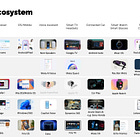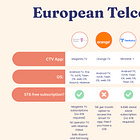Creators go cross-platform and TV wants in
They master the full release window. Here’s what Big Media can learn from them.
Streaming Made Easy is funded by direct subscriptions from readers like you. If you’d like the full experience, consider becoming a Premium member 🫶
For years, traditional TV looked down on creators, the typical phrase from executives being “It’s just kids with iPhones filming from their bedrooms”.
Now, Big Media and Creator Media are on a collision course. One side has deep pockets, legacy influence and decades of storytelling experience. The other: unfiltered authenticity, a loyal community and an ability to adapt at lightning speed.
The challenge? Building a bridge between the two worlds while protecting what makes creator media so relatable and TV so trusted.
Next week (for MIPCOM 2025), I will interview Justine Ryst (MD YouTube France & Southern Europe), Alexia Laroche-Joubert (CEO Banijay France) and creator SparkDise about their Creator lab initiative (5 creators, 5 Banijay IPs, 5 pilots, 50K€ budget per pilot), a sandbox to test how TV storytelling and creator culture can meet halfway. It will take open minds, bold experiments and a few inevitable misfires to build a space where both worlds thrive.
Speaking of which, Gregg Bywalski, from Webedia Creators, spoke at Streaming Made Easy Live. Here’s what we have learnt:
At a glance:
One project, four windows, everybody wins
Co-producing beats managing
Creators aren’t influencers
Three generations, three mindsets
What TV can give back
🎥 Watch Gregg’s fireside chat during Streaming Made Easy Live.
📑 Bonus for Premium subscribers: 📑 Grab our premium edition to download Gregg’s deck on the Creator Economy.
One project, four windows, everybody wins
Take InoxTag, a 22-year-old French creator who built an audience on Fortnite videos. Last year, he swapped the controller for crampons and decided to climb the Everest. The result: a 2½-hour documentary financed by brands, produced by Webedia.
Beyond the extraordinary achievement of climbing the Everest, let’s dig into the distribution strategy itself:
→ One-day theatrical release: 368K tickets sold.
→ YouTube release the next day: 12 million views in 24 hours (36M in 1 month), with average watch time over an hour.
→ TF1 broadcast two weeks later: another 329K viewers.
→ Disney Plus global rollout, while the full film stayed on YouTube (unfortunately no data for us to chew on).
Every window hit a different audience segment instead of cannibalizing the other. It worked because the creator’s DNA stayed intact and the distribution logic finally caught up with how people actually watch.
Co-producing beats managing
Agencies stopped selling one-off brand deals and started building long-term IP with creators, sharing the risk and the reward.
Bywalski’s team doesn’t just sell sponsorships; they build workflows that adapt one master file for every surface (YouTube, TikTok, Twitch, Snapchat, linear TV, SVOD etc.). Long form lives on YouTube. Shorts fuel discovery. Live events drive fandom. It’s the multi-window release perfected.
Creators aren’t influencers
Bywalski was clear on this and it’s a distinction that matters more than most broadcasters realise.
Influencers borrow fame from visibility elsewhere (reality TV, a viral moment, a traditional media push). Their communities follow a persona. Creators build theirs from scratch. No head start, no borrowed spotlight. They earn audiences through formats, consistency and community.
That difference changes everything. Influencers sell moments. Creators build franchises. Influencers monetise reach. Creators monetise relationships. When broadcasters lump both under the same label, they miss the real opportunity. The creator economy isn’t about endorsements, it’s about ownership. Partnerships that treat creators like talent-for-hire collapse fast. Partnerships that treat them like producers last.
Three generations, three mindsets
→ The 1st generation: The YouTube purists, independent to the bone.
→ The 2nd generation: The bridge builders like InoxTag, open to multi-platform deals when authenticity stays intact.
→ The 3rd generation: The live-native crowd. Twitch marathons, charity events, stadium audiences.
Each group needs a different pitch. TV will only win them over by proving it respects community first and control second.
What TV can give back
Creators have scale, not infrastructure. Most don’t archive their rushes, tag metadata, or even keep delivery masters. For years, YouTube was their archive. Now that their content crosses into theatres, linear TV and SVOD, that missing plumbing is slowing them down.
This is where broadcasters can still add massive value. They know delivery standards, file formats, cue sheets, subtitling, rights management and scheduling. They can help creators protect and monetise their back catalogs instead of losing them to the algorithm.
The exchange is clear: creators bring attention, authenticity and data. Broadcasters bring systems, polish and reach. Together they make products that live everywhere, not just on one platform.
TV can definitely teach creators one thing: how to make content last.
🎥 Watch Gregg’s fireside. chat during Streaming Made Easy Live:
That’s it for today but before you go: comments, likes or shares come a long way 🙏🏻
Enjoy your week and see you on Thursday for another edition of Streaming Made Easy!







